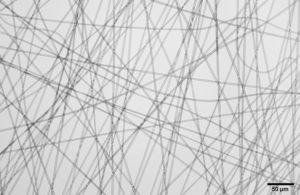
The drug nimodipine, for example, could prevent nerve cells from dying after brain surgery. Health providers already use it to treat cerebral hemorrhages, but it degrades very quickly and has undesirable side effects when delivered intravenously, according to the research team out of Martin Luther University Halle-Wittenberg and University Hospital Halle.
“The neurosurgeons wanted the drug to be applied locally in order to reduce potential side effects,” said professor Karsten Mäder from the Institute of Pharmacy at MLU.
Mäder and his colleagues turned to PLGA, a biodegradable polymer commonly used in medtech, and incorporating nimodipine into the polymer matrix. They developed a method of electrospinning the material into mats made of fibers only 1 to 2 μm thick. Tests on brain cells in vitro demonstrated a sustained drug release over four to eight days, dependent on release conditions, according to the researchers’ paper, recently published in the European Journal of Pharmaceutics and Biopharmaceutics.
The brain cell tests, conducted by the neurosurgery department at University Hospital Halle, found no toxic effects. Under various stress conditions, such as heat or high salt concentrations, the PLGA mats with nimodipine reduced the number of cell deaths, in some cases drastically, with nerve cells particularly benefitting.
The researchers’ paper notes one hitch: They tried electron beam sterilization on the fiber mats, but it reduced drug content considerably.
Still, the fiber mats hold some promise when it comes to providing a way to deliver a drug to the brain — or even another part of the body — in a localized way.
“In the cell systems, we were able to show that the effect was as good as if we had added the active ingredient without the fibers, in other words intravenously,” said professor Christian Scheller at UKH.

